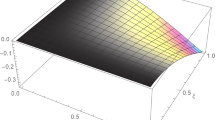Summary.
Backward error analysis is a useful tool for the study of numerical approximations to ordinary differential equations. The numerical solution is formally interpreted as the exact solution of a perturbed differential equation, given as a formal and usually divergent series in powers of the step size. For a rigorous analysis, this series has to be truncated. In this article we study the influence of this truncation to the difference between the numerical solution and the exact solution of the perturbed differential equation. Results on the long-time behaviour of numerical solutions are obtained in this way. We present applications to the numerical phase portrait near hyperbolic equilibrium points, to asymptotically stable periodic orbits and Hopf bifurcation, and to energy conservation and approximation of invariant tori in Hamiltonian systems.
Similar content being viewed by others
Author information
Authors and Affiliations
Additional information
Received October 18, 1995 / Revised version received February 28, 1996
Rights and permissions
About this article
Cite this article
Hairer, E., Lubich, C. The life-span of backward error analysis for numerical integrators. Numer. Math. 76, 441–462 (1997). https://doi.org/10.1007/s002110050271
Issue Date:
DOI: https://doi.org/10.1007/s002110050271



